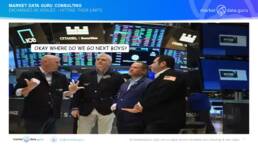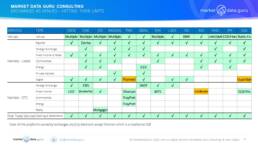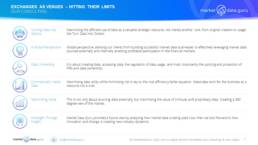

VENUES AND THE FUTURE
The top exchanges are vastly different beasts than they were just 20 years ago. Capital markets have increased in trading, instruments and sophistication in the US and EU accompanied by substantial consolidation, with arguably competition departing markets as liquidity gravitates towards venues with the largest volumes. The only market with significant competition is US equities where CBOE, NASDAQ and NYSE go head to head not only with each other but insurgent CBOE (also active in the Canada, UK, EU, Japan & Australia) and the dark pools. Outside equities, CME, ICE, and NASDAQ have progressively acquired the other futures exchanges. Everywhere exchanges are in the profitable clearing space, and just waiting to monetise the data they have.
In contrast, the EU has seen cross market consolidation, into 4 main venue groups:
1.Deutsche Börse owner of Frankfurt Stock Exchange, Eurex and EEX (Power) plus FX broker 360T
2.Euronext which focuses on listed venues across Europe including in Amsterdam, Brussels, Ireland, Lisbon, Milan, Oslo & Paris, plus Euronext FX and Italian Bond Platform MTS
3.NASDAQ which has hovered up exchanges across the Nordics and Baltics
4.Swiss based SIX now owner of Spain’s BME
In Australia, Canada, Hong Kong, Japan and Singapore markets have consolidated locally with limited transnational exposure, albeit HKEx’s purchase of LME was an oblique China play along with its QME subsidiary, whereas SGX’s buy of the Baltic Exchange makes sense as Singapore is a major shipping and commodities centre. Any moves by a global exchange to buy a local one (partnership is an option though – NASDAQ Dubai), invariably meets the inevitable political outcry
All of these exchanges have expanded their range of listed products, with the curious exception of LSEG which inherited Reuters FX brokerage, but sold off Borsa Italiana/MTS to Euronext as part of their Refinitiv merger. However, these are reaching saturation point as coverage from each exchange of their local markets has become comprehensive as the table below demonstrates.

SUMMARY: EXPANDING PRESENCE IN THE TRADING WORKFLOW AS CORE STRATEGIES
Exchanges can and will continue to list more tradable instruments though finding quality unique assets is becoming harder, just one reason why digital has been embraced, if not always with enthusiasm.
The answer has been to progress from equities to indices on to derivatives, then add other asset classes with varying degrees of success, for instance less than 5% of listed bonds on HKEx regularly trades. Listing competing instruments is one option but if the new product fails to gain liquidity momentum it becomes an also ran, for instance HKEx owned LME’s contracts play second fiddle to CME’s equivalents, and ICE and CME seem to avoid competing with the commodity futures contracts.
Natural saturation points are being reached.
Entering OTC Markets seem an obvious answer, however exchanges have only (and rightly) focused on electronic trading platforms in highly liquid foreign exchange and fixed income markets, CME’s purchase of NEX (EBS & Brokertec) and TMX’s acquisition of Trayport proving astute acquisitions. Even then NASDAQ sold BGC’s original eSpeed platform to Tradeweb having overpaid and failed to make it work.
The exchanges require enough liquidity to drive trading to electronic platforms and this is lacking owing to fragmentation, however the Power markets offer significant scope and attracted interest from the likes of DBAG and ICE. The likelihood of an exchange buying an Inter-Dealer Broker is remote (TMX does own Shorcan), investors demonstrate their aversion, and lack of understanding, of the IDBs through low valuations. Equally while exchanges are tech intensive the IDB’s rely upon human capital to function which comes at a higher cost.
Having said that perhaps an adventurous exchange could buy one of the big 4 IDBs at a bargain cost if it is able to deliver a coherent strategy to develop an IDB, something the IDBs seem to need.
The alternative as the leading Tier 1 exchanges are doing, but where others are lagging, is to go vertical and provide services across the complete trading workflow. These strategies focus around building out information services and solutions businesses to offer end to end products from data, decision tools, pre trade analytics, trading platforms through to post trade solutions.
Our next article takes a look at which exchanges are adopting these strategies.
Talk to us about our consulting, and our independent advisory services
Keiren Harris 28 June 2023
For information on our consulting services please email Knharris@marketdata.guru
https://marketdata.guru/data-compliance
Please contact info@marketdata.guru for a pdf copy of the article
#exchanges #LSEG #NYSE #NASDAQ #equities #futures #derivatives #bonds #fx


